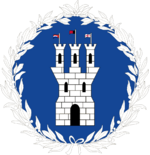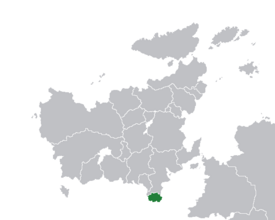Galenia
Republic of Galenia | |
|---|---|
Motto:
| |
| Anthem: Liberty "Liri" | |
| National Seal
Vula Kombëtare e Trekalërisë National Seal of Galenia  | |
 Location of Galenia (in light green), within Euclea (light grey) | |
 | |
| Capital and city | Kartha |
| Official languages | |
| Ethnic groups (2020) |
|
| Demonym(s) | Galenian |
| Government | Unitary presidential constitutional republic |
| Nertilian Bushaj | |
| Hershor Dreshaj | |
| Kthjellor Nexhipi | |
| Legislature | Asambleja Kombëtare |
| Establishment | |
• Galenian League | 208 BCE - 90 CE |
• Trekalërisian Empire | 1222 |
• Apolitan Empire | 1489 |
• First Republic | 1879 - 1880 |
• Second Republic | 1930 - 1931 |
• Independence from Etruria | 1946 |
• Current constitution | 1988 |
| Area | |
• | 62,532 km2 (24,144 sq mi) |
| Population | |
• 2020 estimate | 11,428,245 |
• Density | 182.75/km2 (473.3/sq mi) |
| GDP (PPP) | 2020 estimate |
• Total | $226 billion |
• Per capita | $19,767 |
| GDP (nominal) | 2020 estimate |
• Total | $193 billion |
• Per capita | $16,938 |
| Gini (2020) | 42.4 medium (35th) |
| HDI (2020) | 0.796 high (19th) |
| Currency | Galenian Flori (GLF (ƒ)) |
| Date format | dd/mm/yyyy |
| Driving side | right |
| Calling code | +101 |
| ISO 3166 code | GAL |
| Internet TLD | .ga |
Galenia, officially the Republic of Galenia (Galenian: Republika e Trekalërisë, Novalian: Republika Galenska, Piraese Galenikí Dimokratía), is a sovereign state whose territory is located in the Continent of Euclea, Kylaris. Galenia has a total area of 62,532 square kilometres and a population of 11,329,605 (as of January 2017). Galenia's only border is with Etruria to the north. The capital and most populous city is Kartha, located in the southwestern coast. Other important urban areas of the country includes Mbresht, Tallaz, Kufivalë, and Kallëm.
Galenia was originally inhabited by Gadishullorian Tribes, with the oldest found settlement dating back to the 8th BCE. During the 7th BCE, Lasithi took control over the peninsula, extending the Pirean territory further south. Following the War of the League of Maleme (272 - 259 BCE) and the Eruption at Juktas, the Galenian city-states unite under the leadership of three dominant Polis (Amphitrite, Kymo, Kymodoke), and formed the League of Galenia in 208 BCE. The League did not last long as the Solarian Empire took over the Galenian peninsula in around 90 CE. Following the Solarian Empire's fall, Galenia became a huge conglomerate of small, independent kingdoms. During the 7th century CE, important kingdoms like the Trekalërisë and the Karthë-Tallaz rose in the peninsula; during the same period of time, Marolevians started to migrate south through Novalia, inhabiting most of the northern portion of modern day Galenia. The Kingdom of Trekalërisë gradually took over the peninsula and established the Trekalërisë Empire, renamed as the Apolitan Empire following the Iconoclast Wars.
During the early 18th century, Vespasians defeated the Apolitan Empire and annexed the territory to Novalia. Galenia remained as a region of Novalia until 1879, when Apolitan priest Bujar Zogaj led the Galenian Uprising, proclaiming the independence of Galenia from Etruria. The separatist movement fails and is annexed back into Etruria only 2 months later. In March, 1880, the First Republican March saw thousands of people across the Mbresht-Kartha-Tallaz area protesting against the Etrurian monarchy and claiming independence. In 1888 the new Etrurian republican regime promoted Galenia into a Federal Territory. It remained as such until 1930, when the Galenian Republican Army (URT) declares the Second Galenian Republic as independent from Etruria and it is promptly accepted into the Entente. However, the already mobilizied Etrurian military had no struggle containig the movement in 1931 and retaking Galenia as an Etrurian Territory. Independence only came in 1946, with the conclusion of the Solarian War. The Original Republic lasted until 1961 when the Patriot Party established a military dicatorship in the country. The democratic-leftist oposition started to protest against the current government after president's Xhelal Shkreli death, resulting in a violent political atmosphere in the country. Finally in 1985, following the fall of other Military governments, the current president Skeyënder Molla gradually reestablished the Galenian democracy.
As of the 1988 constitution, Galenia is a unitary presidential constitutional republic with a president elected every four years through popular vote as both Head of State and Head of Government. The incumbet president is Nertilian Bushaj serving since 2017, when the ex-president Endri Toskaj was impeached. Bushaj was elected in 2019 in the formal presidential election and is currently in the second year of his mandate. Legislative power is vested in the unicameral National Assembly, composed of XXX Assembly Members elected to a three-year term. National Assembly elections use the mixed-member proportional (MMP) system. The country struggles with corruption a lot, being considered one of the most corrupt in Euclea.
The Galenian economy is heavily based in the service, industrial and tourism sectors. Galenia is considered one of the most visited countries in Euclea and the world due to its lush beaches and summer resorts. Agriculture also takes a huge part in the economy, in specific olives and tobacco. Galenia has a big brewering industry, being one of the biggest producers of beer in Euclea. Galenia also stands out in the production of wine, though wine consumption is not common in the country. The government has a considerable control on the country's economy, holding shares in key-sectors of the economy. The Galenian state provides universal health care and education in all levels, though it common for Galenians to seek for private services, as those tend to be more efficient. Galenia is an active member of the Community of Nations, International Council for Democracy and the International Trade Organisation. The country is currently in the process of voting a formal Euclean Community membership request.
Etymology

The name Galenia is the Ancient Piraean name of the country. It is most likely derived from the Piraean poet Argyros, during the 7th century BCE, when he referred to the coast of Galenia, near the city of Halinos, as “the land of Galênaiê (Piraean: Γαληναιη).” In ancient Piraean mythology, Galênaiê was the “personification of the calm sea,” making an allusion to the calm and warm seas of Galenia. The term was carried on by the Solarian Empire, who referred to the peninsula as the Galenaea Province. The name would go obsolete following the fall of the Solarian empire and the rise of the Galenian kingdoms, but was introduced again when Galenia became an Etrurian territory in the 19th century.

The name Trekalëri or Trekalëria are found being used starting from the 7th century CE, after the rise of the Trekalërisë Kingdom in the west of the peninsula. Linguists believe that the name is an agglutination of the Galenian words tre (three), kala (castle), and the suffix -ëri, which in the Galenian language represents nouns denoting the state, condition, domain, or jurisdiction, roughly meaning “land of the three castles.” Historians and linguists believe that the name is a reference to the three castles of each city that once composed the Galenian League: Amphitrite, Kymo and Kymodoke, respectively modern day Mbresht, Kufivalë, and Valqëndrush.
History
Antiquity
The first human evidence found in Galenia dates back to the 8th century BCE. Historians struggle to properly determine who inhabited the Galenian peninsula first, but it’s widely accepted that the Gadishullorian Tribes appeared first. It’s uncertain when and why the Gadishullorian ended up in Galenia. Archeologists have found material evidence of Gadishullorian presence in southeast modern-day Galenia that dates back to 800 BCE. On the other side of the peninsula, Piraean people also migrated south, establishing villages and small kingdoms alongside Galenia’s western coast. The modern-day city of Halinos is considered to be the oldest established city in Galenia, founded by Piraeans in 787 BCE. As the Piraean tribes established themselves as city-states, Lasithi grew in power and sought to control and expand its influence. Lasithi fought the Sitia War (448 - 415 BCE), defeating the Polis of Aptera and rising as an Hegemony. By the year of 400 BCE, Lasithi had no difficulties to subjugate and annex all land belonging to the Gadishullorians, finally establishing the whole Galenina peninsula under Piraean control.
As the cultural influence from Lasithi kept growing in the Galenian Polis, their proximity to Gadishullorian people resulted in a culturally different people from the other Piraean people. Though Lasithi kept a firm hand over its dominion, small rebellions were a constant in the Lasithian Galenia. Lasithi’s power was heavily struck after the Eruption at Juktas destroyed their main port. This raised tensions within the Lasithian dominion, resulting in the war of the League of Maleme (272 - 259 BCE). Lasithia was defeated and, with it, lost possession of most of its domain. This left most of the Galenian peninsula fragmented into small Kingdoms and highly decentralized.
As the Lasithi hegemony came to an end, the Prassan hegemony sought to reconquer most of the territory lost by Lasithi. Fearing the threat of being subjugated once again, the Polis of Amphitrite, Kymo, and Kymodoke decided to come together as the Galenian League. Their union attracted many other smaller Polis across the Galenian peninsula. Due to their organization and united power, the Galenian League was able to fight off the Prassan invasion. The League lasted for about 100 years until the whole territory was conquered by the Solarian Empire.
Independent Kingdoms
Trekalërisë Empire
Rise of Religion
Etrurian Years
New Republic
Geography
Climate
Biodiversity
Demographics
Largest cities in Galenia
2017 Census | |||||||||
|---|---|---|---|---|---|---|---|---|---|
| Rank | County | Pop. | |||||||
 Kartha  Mbresht |
1 | Kartha | Karthë | 1,453,549 |  Tallaz  Kufivalë | ||||
| 2 | Mbresht | Mbresht | 848,840 | ||||||
| 3 | Tallaz | Tallaz | 764,617 | ||||||
| 4 | Kufivalë | Bardhylis | 630,587 | ||||||
| 5 | Sorrë | Hëna | 264,683 | ||||||
| 6 | Valqëndrush | Valqëndrush | 259,388 | ||||||
| 7 | Kallëm | Kallëm | 205,346 | ||||||
| 8 | Halinos | Fillim | 189,652 | ||||||
| 9 | Kreshnik | Gjergjë | 169,494 | ||||||
| 10 | Xehet | Xehet | 137,029 | ||||||
Ethnicities
Religion
Languages
Education
Government & Politics
Foreign relations
Military
Administrative divisions
Vietnam is divided into 58 provinces (Vietnamese: tỉnh, from the Chinese 省, shěng). There are also five municipalities (thành phố trực thuộc trung ương), which are administratively on the same level as provinces.
|
|
Karthë (municipality) |
|
|
|




